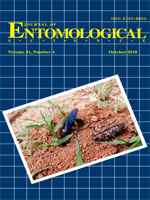Culex pipiens pallens Coquillet can spread various mosquito-borne infectious diseases. This study identifies the overwintering sites and physiological condition of Cx. pipiens during hibernation in Shandong Province of P.R. China. Results show that female adult Cx. pipiens overwinter in habitats characterized by warm temperature, high humidity, and calm winds. Cellars yielded the highest densities, followed by air-raid shelters, caliducts, sewers, mountain caves, wells, stone caverns, etc. The adult density among overwintering sites differed significantly (F = 45.88, P < 0.01). Larvae and pupae were not captured after late December. In early winter, multiparous and bloodsucking mosquitoes accounted for a large proportion of the observed populations. However, their numbers gradually decreased as winter progressed, mainly due to their relatively high death rate in winter. Most mosquitoes overwinter in a state of diapause, and females have usually mated. Collections in midwinter showed that of those collected, 99.8% were in diapause and 100% had mated. Overwintering mosquitoes suffered few deaths under natural conditions and, upon emerging from overwintering diapause, could take blood meals and oviposit. The time taken for oviposition by mosquitoes emerging from diapause was longer than that observed with females continuously reared in the laboratory; however, there was no significant difference in the numbers of eggs (F = 0.571, P = 0.467) oviposited.
BioOne.org will be down briefly for maintenance on 17 December 2024 between 18:00-22:00 Pacific Time US. We apologize for any inconvenience.
How to translate text using browser tools
1 October 2016
Overwintering of Culex pipiens pallens (Diptera: Culicidae) in Shandong, China
Lijuan Liu,
Benguang Zhang,
Peng Cheng,
Huaiwei Wang,
Xiuxia Guo,
Chongxing Zhang,
Haifang Wang,
Yuqiang Zhao,
Maoqing Gong
ACCESS THE FULL ARTICLE
Culex pipiens pallens
fecundity
overwintering sites
physiology condition





